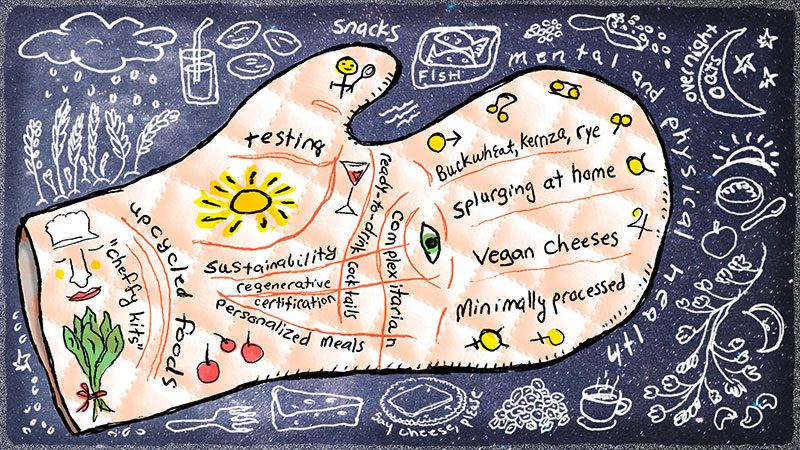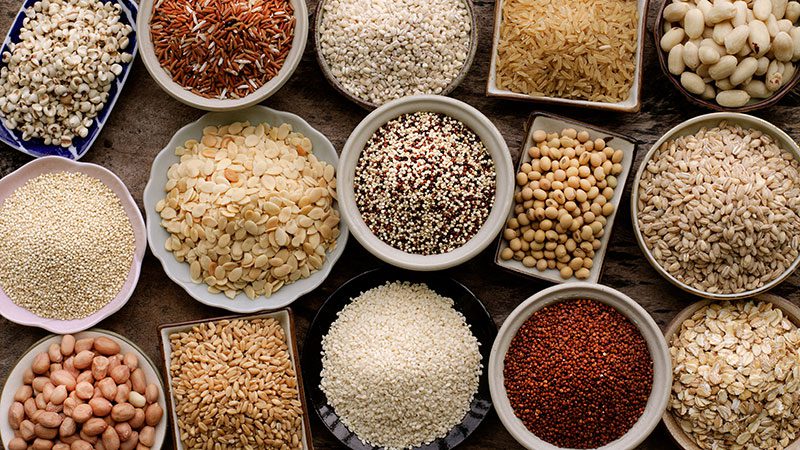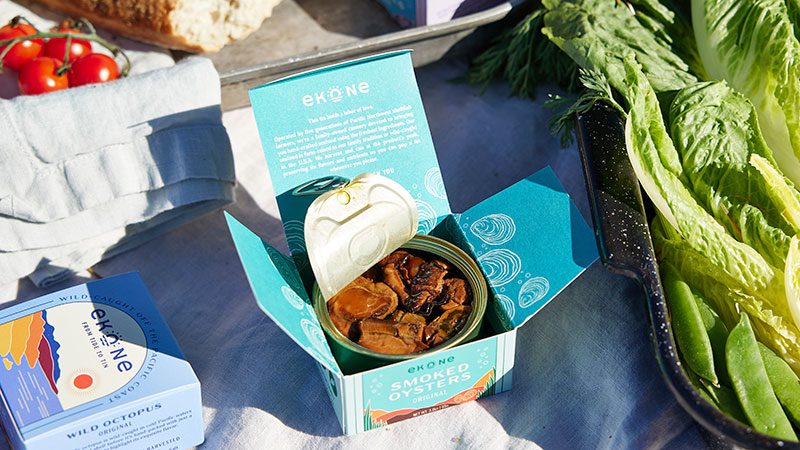Top food trends for 2025
By Rebekah Denn

Illustration by Wendy Wahman.
Buckwheat? In. Tinned fish? Same. Functional foods and clean labels are hot, high-end restaurants are not. Those are just some of the food trends to watch in 2025, according to researchers, innovators and other experts consulted by PCC.
One big theme: Shoppers want more from their foods and are setting new priorities. For instance, “upcycled foods,” created from byproducts that would otherwise go to waste, remain desirable. But consumers now insist upcycled foods actually taste good in addition to doing good, noted Shelley Balanko, senior vice president of Hartman Group, a Bellevue-based market research firm specializing in food, health and sustainability.
“There needs to be more than just a sustainability benefit… Those who may have felt like they were making a little bit of sacrifice in terms of taste or nutrition, they’re calling for more.”
In no particular order, here are 2025 takes from our trendspotters:
Testing and transparency
Max Goldberg, founder of the Organic Insider newsletter, says “I think we’re moving into much more of a testing world.” Major companies like Oatly and Jovial have their products certified as glyphosate-residue free, submitting products for independent testing to prove the label claims. Manufacturer Zego Foods, Goldberg noted, tests for everything from gluten to fungicides, sharing test results with consumers. Parents shocked by contamination in baby foods have demanded proof that the brands they purchase are free of heavy metals, and Goldberg thinks that will carry through as the toddlers become tweens and teens. “I think this is a trend for the next 10 years.”
Regenerative certification: That “prove it” trend includes an ongoing flood of support for regenerative agriculture and certified regenerative products, with a PCC symposium on regenerative agriculture cited in a recent Hartman report. There is “a fair amount of trust in the USDA Organic certification,” Balanko said. Consumers don’t think it’s perfect, though, and are looking for more. Enter regenerative.
Many products vague-boast regenerative practices, but “to have that third-party seal is a really strict bar,” said Sophie Egan, a food and sustainability expert and author of “How to be a Conscious Eater.” She found it “staggering” how quickly producers have sought out the Regenerative Organic Certification (ROC) label, which requires USDA organic certification and builds on that, already listing more than 1800 certified products. There are a handful of regenerative certifications now available, though ROC appears to be taking the lead.
“I tend to value third party certifiers as kind of the referees of food marketing. I do think it’s a positive sign that there are so many companies or brands that are going to the trouble there,” Egan said.
Personalized meals: If you checked out the Smart Kitchen Summit on food and technology earlier this year in Seattle, you saw a vision of the future where artificial intelligence and smarter software help shoppers plan, shop, and cook on a super-personalized scale. Speakers envisioned taking photos of finished restaurant dishes that would then generate a recipe and shopping list, automatically redesigning recipes to make them keto or vegetarian, even designing meals to boost their personal body chemistries and nutritional profiles. Some of the technology is underway or imperfectly in place, look for it to become more efficient and functional. One red-hot and apparently achievable goal: Getting relevant recommendations when grocery shopping online.
Going “Complexitarian”
Plant-based foods remain a prime focus for diners. We see that with vegetarians, pescatarians and even flexitarians… but Egan cites “complexitarian” diners for the latest twists in the trend. Those diners, accepting more nuance and different routes toward a goal, are reducing the amount of meat they eat by mixing it with plant-based ingredients — chickpeas, mushroom mixtures, even mashed eggplant.
In other plant-based trends, PCC retail deli manager Tristan Ambrose notes intense interest in vegan cheese — not just plant-based cheeses that can be used for cooking, but true artisan-crafted vegan cheese selections being introduced to stores.
Not-Impossible Foods: Egan also sees the pendulum swinging toward whole and minimally processed plant-based foods rather than the ultra-processed “meat substitutes” that seemed recently poised to rule the dinner table. “People don’t like the ambiguity of “What’s in this thing?” (with ultra-processed foods), but they still want a veggie burger sometimes,” she said. So they might go for a veggie burger made with whole ingredients like mushrooms or lentils — or just opt for a bowl of lentils or a chickpea salad, “versus mimicry as the end goal.”

Buckwheat and Kernza: In that same lane comes a surge of interest in diverse whole grains that go beyond whole wheat.
Overnight oats show no signs of slowing down, said Ambrose. Interest in regenerative foods helped spark plans to bring cookies into the PCC deli in 2025 made with Kernza, she said, a perennial grain hailed as a potential food of the future. Mike Wenrick, PCC’s Director of Purpose, agrees and also sees a new focus on other carbon sequestering grains like rye.
Among the general enthusiasm, Goldberg sees specific momentum for buckwheat, which has even emerged as a new plant-based milk. Buckwheat is “incredibly nutritious,” he noted, it’s good for the environment and soil health, it can be intercropped with what farmers in the Midwest are already growing… and it tastes good too.
Diverse whole grains are a climate-smart choice, Egan said, but that’s not why most consumers are choosing them. “Very consistently, consumer insights data shows that the top drivers of food choices are taste, cost, health, convenience. Sustainability is way down on the list,” she said. And yet, consumers are “kind of backing into sustainable foods, if you will, not going there for their sustainability attributes, but for their health, taste, for cost reasons.”
Health is wealth
Health is a priority for consumers — and a premium goal when choosing foods these days. “They’re struggling to feed their families in a way that aligns with their health and wellness values and goals,” Balanko said. She also sees a dip in enthusiasm for sustainable foods. On an intellectual level shoppers might appreciate the benefits, and they know some culinary distinctions are worth paying for, but “generally speaking, they’re going to pay more for the thing that is going to keep them safe, make them healthier, make them perform better.”

Photo credit: Feed It Creative
Splurging at home: On the flip side, while rising costs have made many shoppers focus on other priorities and cut out restaurant meals, there’s a lift in sales of some luxury ingredients like prime rib. “It’s splurging on dinner at home because it’s so expensive to eat out,” Egan said. The little home luxuries she sees also include charcuterie boards and a new enthusiasm for tinned fish, supported by new cookbooks, British cooking shows and an array of new gorgeously packaged tins of mussels and salmon and anchovies and such that make for small — but fancy — indulgences. Peter Boeger, PCC’s wine, beer and spirits merchandiser, sees ready-to-drink cocktails on the rise, while the Specialty Food Association anticipates “cheffy kits for the home cook” providing restaurant quality meals at the kitchen table.
Food is more than medicine: “I think that the mental health component of food is going to become way more of a central focus,” said Egan. A recent study showed that more than 3 out of 4 Americans believe food and beverage choices impact their mental and emotional wellbeing, she noted. Within that, she sees more focus on longevity and eating for health — “not just to live a long time, but to live quality years. How high functioning are you? How agile? How much energy do you have, how much endurance on a given day?” Intriguing ingredients tying into that trend go beyond the probiotic sodas and “prebiotic” foods and functional mushrooms, into avocado leaves, botanicals and herbal infusions like bergamot and kumquat.
Closing thoughts
Good news? Balanko sees some brands providing more sustainable packaging that’s easier to recycle. Consumers have been disillusioned despite their best intentions because of the barriers to recycling and composting as individuals. Now, “we’re starting to see some brands take some of the onus off the consumer” and take responsibility for creating more sustainable packaging on their end.
Think about: Tracy Marik, PCC’s Fresh Director, is concerned about overreliance on the Cavendish banana, a monocrop that has been edging out hundreds of other types of bananas in the world. It’s Exhibit A of a dangerous lack of diversity in global food chains. Bananas are the most-consumed fruit in the world — and quite possibly the most at risk, with a chance they’ll be wiped out from a fungal disease. Marik’s focused on how PCC can be an advocate for driving greater diversity — a generally important goal, and just the kind of step Food & Wine magazine says will be needed to save bananas from extinction.
Your turn: See a trend in the making that’s not listed here? Talk to us at editor@pccmarkets.com; your comments may be included in a future article or social media post.
